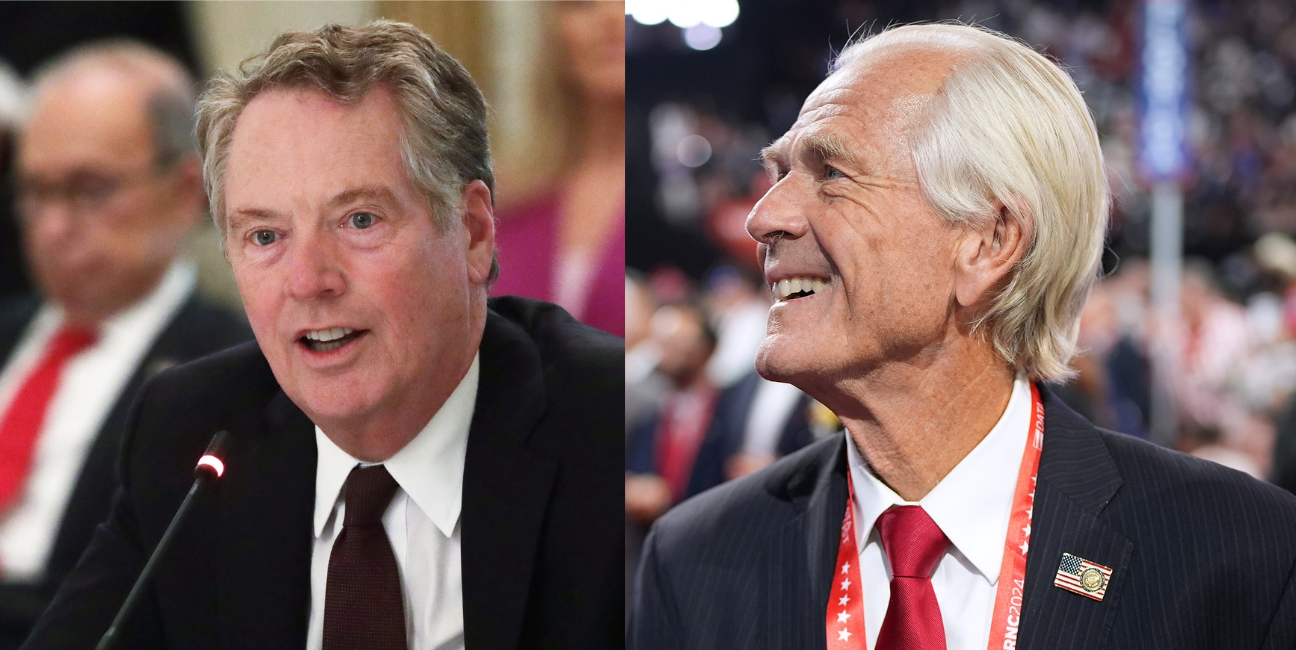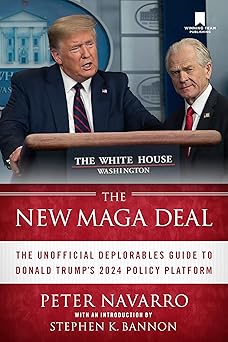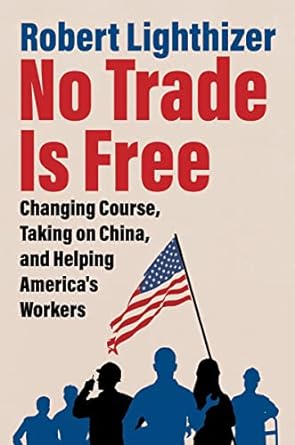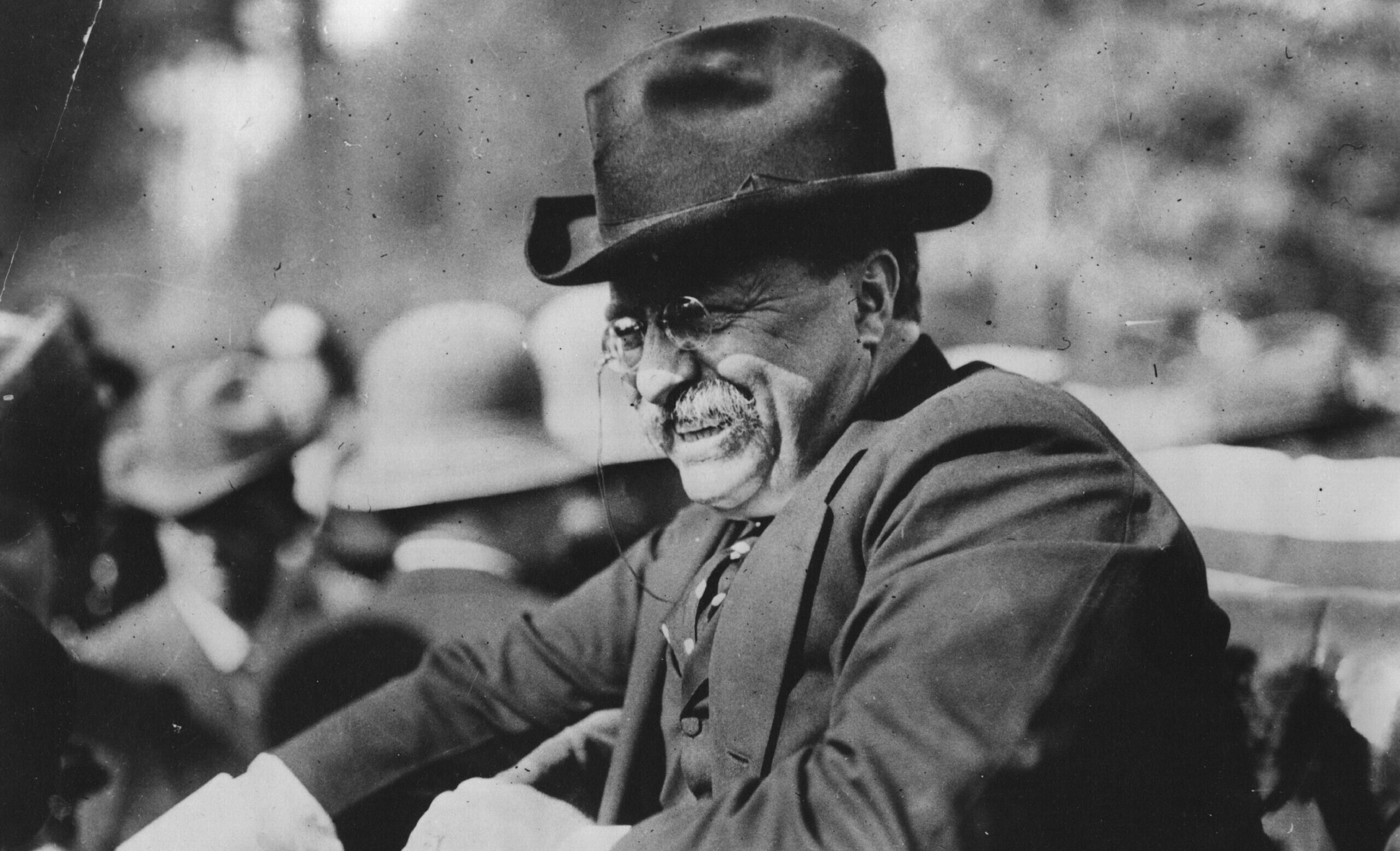To say Donald Trump faced opposition like no other president understates his first-term predicament. Not only did he contend with the usual suspects who have treated every Republican president since Richard Nixon with contempt, but he also found himself up against GOP congressional leaders and many of his own White House appointees and cabinet members, who failed to support his nationalist-populist vision of making manufacturing great again.
The most faithfully committed of his economic advisors were Robert Lighthizer, who served in Trump’s cabinet as U.S. Trade Representative, and Peter Navarro, director of the White House Office of Trade and Manufacturing Policy. Now in their mid-seventies, both men will likely serve in a potential second Trump term. In two new books, each of these standouts explains, defends, and advances Trump’s working-and-middle-class economic vision, which was only partially implemented in the first administration.
Like the two men’s respective backgrounds, skill sets, and temperaments, their books couldn’t be more different. The detailed and carefully written No Trade Is Free reflects the expertise of a lifelong Republican who forged a career practicing trade law in the nation’s capital, including serving as Ronald Reagan’s deputy trade representative. Lighthizer’s scholarly but readable volume represents the definitive argument for balanced trade, rooted in American history and his own experience, and it will appeal to policy mavens. Its comprehensiveness might persuade GOP free-trade holdouts.
The New MAGA Deal offers lighter fare—an assortment of articles quickly assembled and mostly written by Peter Navarro, who deeply connects with average voters in this “unofficial deplorables guide” to a second Trump term. An array of authors, including Stephen K. Bannon, Richard Grinnell, and Russ Vought, contribute to the book, but the bulk of its thirty-seven chapters are by Navarro.
Every bit as credentialed as Lighthizer, the economics professor emeritus Navarro is more the political fighter: he not only advised Trump on policy during the 2016 campaign but also wore several hats in the White House. While Navarro tackles a dazzling array of issues, twenty-three chapters focus directly on economics and trade or related topics, from Big Tech and China’s geopolitical threat to national security and illegal immigration.
Debunking Postindustrial Economics
No Trade Is Free helps to explain the emergence of the twenty-first-century “fake economy,” as Senator J. D. Vance calls it—one dominated by consulting, high finance, and globalist trade—as opposed to the domestic manufacturing, defense-related R&D, and transportation infrastructure that America’s political economy favored in the twentieth century.
Mindful of how the older economic order delivered the American Dream while he was growing up in northeast Ohio, then an industrial powerhouse that claimed more Fortune 500 headquarters than New York City, Lighthizer blasts the adoption of U.S. trade policies that sold out a lion’s share of Middle America’s private-sector livelihoods. The sellouts include the 1993 ratification of NAFTA and the creation of the World Trade Organization (WTO) by a Democratic Congress, as well as the elevation of Communist China as a “most favored nation” trading partner (and afforded WTO membership) by a Republican Congress in 2000, all of which Lighthizer formally testified against.
Lighthizer takes on the academic economists who still worship globalist supply chains, debunking their neoclassical trade theories and obsession with GDP numbers. His assessment of recurring merchandise-trade shortfalls since the end of the Cold War should settle the question once and for all. Decades of skyrocketing American trade deficits, rising to $1.1 trillion in each of the last three years, do indeed matter. As Lighthizer warns: “Long-term trade deficits must be financed through asset sales,” like a homeowner who takes out a second mortgage to cover living expenses.
That foreigners are purchasing U.S. assets with our recycled trade dollars also matters, as “the new owners get the future earnings of those assets as well, for all time.” He then delivers a final punch: “Running up gigantic trade deficits with one’s geopolitical adversary is particularly stupid,” which in our case means shipping “hundreds of billions of dollars’ worth of our wealth to China every year.”
Lighthizer rescues Ronald Reagan from the ideologues who claim the Great Communicator was a free trader. He recalls how the fortieth president fought trade imbalances by deploying his Treasury secretary to negotiate the 1985 New York Plaza Accord, where our allies agreed to appreciate their currencies, thus making U.S.-made products competitive. Reagan also imposed tariffs and quotas on steel, semiconductors, and automobiles. More a forerunner of Trump than many Republicans realize, Reagan was bullish about preserving U.S. industrial capacity and middle-class jobs.
While proud of helping the consummate outsider turn the tables on a rigged trade game that invited allies and adversaries alike to walk all over us, Lighthizer reveals a missed opportunity under President Trump. Tucked away in Chapter 17 is a lament that in early 2017, before his Senate confirmation, the then–trade representative nominee wasn’t able to weigh in on White House discussions about legislation that would be finalized later that year, the Tax Cuts and Jobs Act. Because the big banks prevailed over manufacturing interests, the legislation omitted a game-changing provision that House Ways and Means Chairman Kevin Brady had proposed in 2016: a border-adjustable tax that would have compensated for revenue losses from the business tax breaks while boosting long-term investments at home by rewarding U.S. companies for exports.
Apart from that disappointment, Lighthizer identifies unfinished business for a next administration, an ambitious checklist that includes “strategic decoupling” from China, repealing its “permanent normal trade relations” status, requiring trade reciprocity with our partners and allies, and achieving balanced trade via across-the-board tariffs, a policy to which Trump committed last year.
Such prescriptions move from the conclusion of No Trade Is Free to the heart of The New MAGA Deal, where Navarro essentially translates Lighthizer’s to-do list, along with many other policy points, into prose average voters can quickly grasp.
Navarro is fully on board with his colleague on trade and China, yet pushes further, calling for extending Trump’s 2017 tax cuts while strengthening the buy-and-hire-American principles that Trump implemented, particularly in federal procurement and contracting. And given the urgency of the upcoming election, Navarro punches hard against the disasters of the Biden–Harris administration, from runaway inflation driven by the retreat on energy production and out-of-control spending to the border explosion and foreign-policy failures, laying out how the former president will bring America back from the brink.
The stakes are personal for Navarro, who served jail time rather than disclose confidential communications with the former president, ignoring subpoenas from the House January 6th Committee.
Navarro teases out a full policy agenda, covering the woke–DEI nonsense, the crises in education and children’s health, and the weaponization of the Justice Department and FBI with policy recommendations for more than one hundred immediate presidential actions. Yet the economic concerns that motivate Lighthizer remain central to Navarro’s blueprint, as Navarro equates the heart of MAGA with “Populist Economic Nationalism.” Indeed, the first leg of his “iron MAGA triangle,” he writes, “is to strengthen America’s manufacturing and defense industrial base.”
As Lighthizer does with the case for balanced trade, Navarro appeals to the continuity between Trump and Reagan, who promised in his 1980 nomination acceptance speech “a great national crusade to make America great again.”
Shortchanging the Industrial Policy Challenge
This reviewer, who served at lower levels in the Trump administration, hesitates to spot a weak link in either book, but I fear both may shortchange all that will be required for a return to American greatness. As much as Trump conservatives support reversing the policies of globalization and financialization and rebooting America’s technological-industrial prowess, these two books—like other policy guides prepared by Trump-friendly think tanks—imply that if we put the right tariffs in place, keep our business tax rates competitive, and scale back regulations, we can trigger a manufacturing renaissance. Yet the free market by itself will not re-industrialize America.
Most Republicans are open to a limited industrial policy and will concur with Lighthizer, who warns we will lose on the world stage if we don’t subsidize “specific crucial industries.” He hails the CHIPS and Science Act of 2022 as “a good first step” but also names, as examples of fields needing special investment and protection, “artificial intelligence, robotics, advanced materials, and other industries of the future.”
But it’s not just next-generation industries that need federal direction and money. As my former colleague Kevin L. Kearns of the U.S. Business and Industry Council observes:
Our capacities in capital or producers’ goods (the machines at the heart of manufacturing) as well as commercial shipbuilding and steel production (irreplaceable underpinnings of our economic and military might) have suffered a Depression-like contraction. And other U.S. legacy manufacturing sectors, from consumer goods to advanced electronics and telecommunications, barely exist anymore. The eclipse of all these once world-beating sectors has handicapped our ability to innovate and lead in emerging science and technology fields, because the shape of future industries is built upon the success of current industries.
Kearns believes that a President Trump 2.0 will therefore need to follow the footsteps of Franklin Roosevelt, who recruited William Knudsen, president of General Motors and lifelong Republican, to spearhead an “all-of-government and all-of-industry campaign” to build the Arsenal of Democracy, an effort that started eighteen months before Pearl Harbor. Facing an eerily similar predicament with China, we need a comparable national manufacturing plan. That might require reviving Herbert Hoover’s Reconstruction Finance Corporation (RFC) with its expansion under FDR into the War Production Board and the Defense Plant Corporation. Such a comprehensive strategy, reclaiming not only U.S. self-reliance but also dominance in industries required of a superpower, would represent a 180-degree pivot from the globalist, laissez-faire approach we have followed since the early 1990s. Kearns estimates that a full restoration of American manufacturing will take more than a decade to achieve.
If any public figure could set America on this needed course, Trump can. Drawing upon Robert Lighthizer and Peter Navarro, the former and potential future president could, picking up where he left off, put us back on a trajectory to make U.S. industry great again.
















